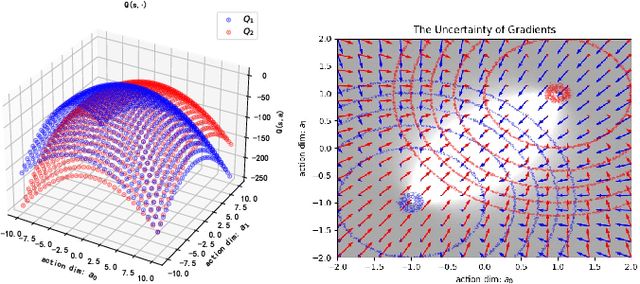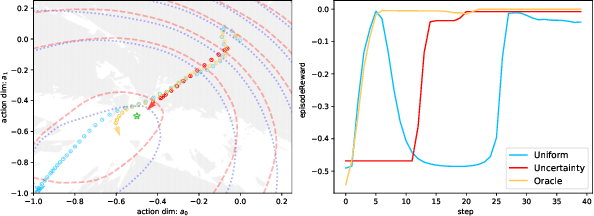Changjie Fan
NetEase Fuxi AI Lab
Digital Player: Evaluating Large Language Models based Human-like Agent in Games
Feb 28, 2025Abstract:With the rapid advancement of Large Language Models (LLMs), LLM-based autonomous agents have shown the potential to function as digital employees, such as digital analysts, teachers, and programmers. In this paper, we develop an application-level testbed based on the open-source strategy game "Unciv", which has millions of active players, to enable researchers to build a "data flywheel" for studying human-like agents in the "digital players" task. This "Civilization"-like game features expansive decision-making spaces along with rich linguistic interactions such as diplomatic negotiations and acts of deception, posing significant challenges for LLM-based agents in terms of numerical reasoning and long-term planning. Another challenge for "digital players" is to generate human-like responses for social interaction, collaboration, and negotiation with human players. The open-source project can be found at https:/github.com/fuxiAIlab/CivAgent.
Rank Aggregation in Crowdsourcing for Listwise Annotations
Oct 10, 2024



Abstract:Rank aggregation through crowdsourcing has recently gained significant attention, particularly in the context of listwise ranking annotations. However, existing methods primarily focus on a single problem and partial ranks, while the aggregation of listwise full ranks across numerous problems remains largely unexplored. This scenario finds relevance in various applications, such as model quality assessment and reinforcement learning with human feedback. In light of practical needs, we propose LAC, a Listwise rank Aggregation method in Crowdsourcing, where the global position information is carefully measured and included. In our design, an especially proposed annotation quality indicator is employed to measure the discrepancy between the annotated rank and the true rank. We also take the difficulty of the ranking problem itself into consideration, as it directly impacts the performance of annotators and consequently influences the final results. To our knowledge, LAC is the first work to directly deal with the full rank aggregation problem in listwise crowdsourcing, and simultaneously infer the difficulty of problems, the ability of annotators, and the ground-truth ranks in an unsupervised way. To evaluate our method, we collect a real-world business-oriented dataset for paragraph ranking. Experimental results on both synthetic and real-world benchmark datasets demonstrate the effectiveness of our proposed LAC method.
Storynizor: Consistent Story Generation via Inter-Frame Synchronized and Shuffled ID Injection
Sep 29, 2024



Abstract:Recent advances in text-to-image diffusion models have spurred significant interest in continuous story image generation. In this paper, we introduce Storynizor, a model capable of generating coherent stories with strong inter-frame character consistency, effective foreground-background separation, and diverse pose variation. The core innovation of Storynizor lies in its key modules: ID-Synchronizer and ID-Injector. The ID-Synchronizer employs an auto-mask self-attention module and a mask perceptual loss across inter-frame images to improve the consistency of character generation, vividly representing their postures and backgrounds. The ID-Injector utilize a Shuffling Reference Strategy (SRS) to integrate ID features into specific locations, enhancing ID-based consistent character generation. Additionally, to facilitate the training of Storynizor, we have curated a novel dataset called StoryDB comprising 100, 000 images. This dataset contains single and multiple-character sets in diverse environments, layouts, and gestures with detailed descriptions. Experimental results indicate that Storynizor demonstrates superior coherent story generation with high-fidelity character consistency, flexible postures, and vivid backgrounds compared to other character-specific methods.
StyleTalk++: A Unified Framework for Controlling the Speaking Styles of Talking Heads
Sep 14, 2024



Abstract:Individuals have unique facial expression and head pose styles that reflect their personalized speaking styles. Existing one-shot talking head methods cannot capture such personalized characteristics and therefore fail to produce diverse speaking styles in the final videos. To address this challenge, we propose a one-shot style-controllable talking face generation method that can obtain speaking styles from reference speaking videos and drive the one-shot portrait to speak with the reference speaking styles and another piece of audio. Our method aims to synthesize the style-controllable coefficients of a 3D Morphable Model (3DMM), including facial expressions and head movements, in a unified framework. Specifically, the proposed framework first leverages a style encoder to extract the desired speaking styles from the reference videos and transform them into style codes. Then, the framework uses a style-aware decoder to synthesize the coefficients of 3DMM from the audio input and style codes. During decoding, our framework adopts a two-branch architecture, which generates the stylized facial expression coefficients and stylized head movement coefficients, respectively. After obtaining the coefficients of 3DMM, an image renderer renders the expression coefficients into a specific person's talking-head video. Extensive experiments demonstrate that our method generates visually authentic talking head videos with diverse speaking styles from only one portrait image and an audio clip.
EA-RAS: Towards Efficient and Accurate End-to-End Reconstruction of Anatomical Skeleton
Sep 03, 2024



Abstract:Efficient, accurate and low-cost estimation of human skeletal information is crucial for a range of applications such as biology education and human-computer interaction. However, current simple skeleton models, which are typically based on 2D-3D joint points, fall short in terms of anatomical fidelity, restricting their utility in fields. On the other hand, more complex models while anatomically precise, are hindered by sophisticate multi-stage processing and the need for extra data like skin meshes, making them unsuitable for real-time applications. To this end, we propose the EA-RAS (Towards Efficient and Accurate End-to-End Reconstruction of Anatomical Skeleton), a single-stage, lightweight, and plug-and-play anatomical skeleton estimator that can provide real-time, accurate anatomically realistic skeletons with arbitrary pose using only a single RGB image input. Additionally, EA-RAS estimates the conventional human-mesh model explicitly, which not only enhances the functionality but also leverages the outside skin information by integrating features into the inside skeleton modeling process. In this work, we also develop a progressive training strategy and integrated it with an enhanced optimization process, enabling the network to obtain initial weights using only a small skin dataset and achieve self-supervision in skeleton reconstruction. Besides, we also provide an optional lightweight post-processing optimization strategy to further improve accuracy for scenarios that prioritize precision over real-time processing. The experiments demonstrated that our regression method is over 800 times faster than existing methods, meeting real-time requirements. Additionally, the post-processing optimization strategy provided can enhance reconstruction accuracy by over 50% and achieve a speed increase of more than 7 times.
LLM4GEN: Leveraging Semantic Representation of LLMs for Text-to-Image Generation
Jun 30, 2024



Abstract:Diffusion Models have exhibited substantial success in text-to-image generation. However, they often encounter challenges when dealing with complex and dense prompts that involve multiple objects, attribute binding, and long descriptions. This paper proposes a framework called \textbf{LLM4GEN}, which enhances the semantic understanding ability of text-to-image diffusion models by leveraging the semantic representation of Large Language Models (LLMs). Through a specially designed Cross-Adapter Module (CAM) that combines the original text features of text-to-image models with LLM features, LLM4GEN can be easily incorporated into various diffusion models as a plug-and-play component and enhances text-to-image generation. Additionally, to facilitate the complex and dense prompts semantic understanding, we develop a LAION-refined dataset, consisting of 1 million (M) text-image pairs with improved image descriptions. We also introduce DensePrompts which contains 7,000 dense prompts to provide a comprehensive evaluation for the text-to-image generation task. With just 10\% of the training data required by recent ELLA, LLM4GEN significantly improves the semantic alignment of SD1.5 and SDXL, demonstrating increases of 7.69\% and 9.60\% in color on T2I-CompBench, respectively. The extensive experiments on DensePrompts also demonstrate that LLM4GEN surpasses existing state-of-the-art models in terms of sample quality, image-text alignment, and human evaluation. The project website is at: \textcolor{magenta}{\url{https://xiaobul.github.io/LLM4GEN/}}
Character-Adapter: Prompt-Guided Region Control for High-Fidelity Character Customization
Jun 24, 2024Abstract:Customized image generation, which seeks to synthesize images with consistent characters, holds significant relevance for applications such as storytelling, portrait generation, and character design. However, previous approaches have encountered challenges in preserving characters with high-fidelity consistency due to inadequate feature extraction and concept confusion of reference characters. Therefore, we propose Character-Adapter, a plug-and-play framework designed to generate images that preserve the details of reference characters, ensuring high-fidelity consistency. Character-Adapter employs prompt-guided segmentation to ensure fine-grained regional features of reference characters and dynamic region-level adapters to mitigate concept confusion. Extensive experiments are conducted to validate the effectiveness of Character-Adapter. Both quantitative and qualitative results demonstrate that Character-Adapter achieves the state-of-the-art performance of consistent character generation, with an improvement of 24.8% compared with other methods
Bayesian Design Principles for Offline-to-Online Reinforcement Learning
May 31, 2024Abstract:Offline reinforcement learning (RL) is crucial for real-world applications where exploration can be costly or unsafe. However, offline learned policies are often suboptimal, and further online fine-tuning is required. In this paper, we tackle the fundamental dilemma of offline-to-online fine-tuning: if the agent remains pessimistic, it may fail to learn a better policy, while if it becomes optimistic directly, performance may suffer from a sudden drop. We show that Bayesian design principles are crucial in solving such a dilemma. Instead of adopting optimistic or pessimistic policies, the agent should act in a way that matches its belief in optimal policies. Such a probability-matching agent can avoid a sudden performance drop while still being guaranteed to find the optimal policy. Based on our theoretical findings, we introduce a novel algorithm that outperforms existing methods on various benchmarks, demonstrating the efficacy of our approach. Overall, the proposed approach provides a new perspective on offline-to-online RL that has the potential to enable more effective learning from offline data.
vMFER: Von Mises-Fisher Experience Resampling Based on Uncertainty of Gradient Directions for Policy Improvement
May 14, 2024


Abstract:Reinforcement Learning (RL) is a widely employed technique in decision-making problems, encompassing two fundamental operations -- policy evaluation and policy improvement. Enhancing learning efficiency remains a key challenge in RL, with many efforts focused on using ensemble critics to boost policy evaluation efficiency. However, when using multiple critics, the actor in the policy improvement process can obtain different gradients. Previous studies have combined these gradients without considering their disagreements. Therefore, optimizing the policy improvement process is crucial to enhance learning efficiency. This study focuses on investigating the impact of gradient disagreements caused by ensemble critics on policy improvement. We introduce the concept of uncertainty of gradient directions as a means to measure the disagreement among gradients utilized in the policy improvement process. Through measuring the disagreement among gradients, we find that transitions with lower uncertainty of gradient directions are more reliable in the policy improvement process. Building on this analysis, we propose a method called von Mises-Fisher Experience Resampling (vMFER), which optimizes the policy improvement process by resampling transitions and assigning higher confidence to transitions with lower uncertainty of gradient directions. Our experiments demonstrate that vMFER significantly outperforms the benchmark and is particularly well-suited for ensemble structures in RL.
A Dataset for the Validation of Truth Inference Algorithms Suitable for Online Deployment
Mar 10, 2024



Abstract:For the purpose of efficient and cost-effective large-scale data labeling, crowdsourcing is increasingly being utilized. To guarantee the quality of data labeling, multiple annotations need to be collected for each data sample, and truth inference algorithms have been developed to accurately infer the true labels. Despite previous studies having released public datasets to evaluate the efficacy of truth inference algorithms, these have typically focused on a single type of crowdsourcing task and neglected the temporal information associated with workers' annotation activities. These limitations significantly restrict the practical applicability of these algorithms, particularly in the context of long-term and online truth inference. In this paper, we introduce a substantial crowdsourcing annotation dataset collected from a real-world crowdsourcing platform. This dataset comprises approximately two thousand workers, one million tasks, and six million annotations. The data was gathered over a period of approximately six months from various types of tasks, and the timestamps of each annotation were preserved. We analyze the characteristics of the dataset from multiple perspectives and evaluate the effectiveness of several representative truth inference algorithms on this dataset. We anticipate that this dataset will stimulate future research on tracking workers' abilities over time in relation to different types of tasks, as well as enhancing online truth inference.
 Add to Chrome
Add to Chrome Add to Firefox
Add to Firefox Add to Edge
Add to Edge